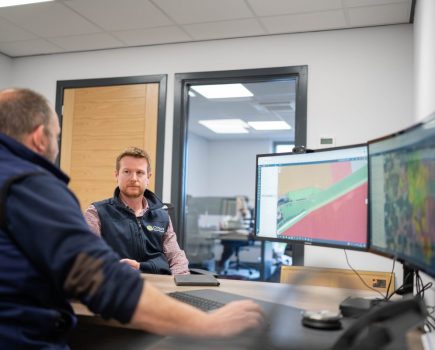There’s endless talk about AI in the media at the moment but arguably a limited amount of discussion regarding what the technology could do for farming. CPM explores its potential for the industry.
“Using AI tools and open-source data we’ve created a prototype digital-earth-twin.” TOMISLAV HENGL
By Melanie Jenkins
From intuitive soil mapping to intelligent weeding, or even highly advanced plant breeding techniques, AI is expanding into agriculture at speed.
According to the World Economic Forum, AI in agriculture is projected to grow from $1.7Bn (£1.3Bn) in 2023 to $4.7Bn (£3.5Bn) by 2028. Firms aren’t only seeking to solve the problems faced by the industry, but are taking innovative new approaches to advance it to the next level.
For one, AI 4 Soil Health is utilising AI to create layered soil maps which could revolutionise how soil is managed, with the organisation claiming it could be used to model solutions for the future impacts of climate change.
“The Soil Health Data Cube Map will help policy makers, farmers and land managers better manage our soils for biodiversity, carbon storage and productive farmland,” says AI 4 Soil Health and OpenGeoHub’s Tomislav Hengl.
“Using AI tools and open-source data we’ve created a prototype digital-earth-twin – a map of European soil health which will enable users to analyse and test soil management practices to deliver better outcomes and environmental benefits and to predict the impact of different climate change scenarios.
“This is probably the most sophisticated soil health modelling framework to date. It’ll be an indispensable tool for those involved in regenerative agriculture, carbon farming, and those looking to change farming land use systems – such as realising soil carbon sequestration potential, shifting to agroforestry and similar.
“We’ll be able to provide the modelling capability to empower them with real world evidence while significantly reducing the cost, time and labour involved in traditional soil monitoring practices,” he explains.
Around 100 scientists have contributed to the project, which integrates hundreds of thousands of observations and data points on soil, climate and vegetation using a multidimensional matrix powered by artificial intelligence and high-performance computing.
This new tool allows scientists and researchers to obtain open data representing European landscape and soil properties in space and time, and can potentially be used to simulate complex scenarios and accurately predict, test and model real world solutions.
The Soil Health Data Cube Map enables users to monitor key soil health factors including pH levels, soil carbon, and biological parameters over time with weather and climate data. Its spatial resolution is down to 20m or 30m with the addition of vegetation cover and most recently more than 20M European crop field boundaries.
Farmers will be able to access and view an accurate picture of their farms, exploring historical and future patterns of soil health based on different climatic and land use scenarios.
Although this is the first version, the team plans to develop the data cube further during the next three years by populating it with significant volumes of additional data together with new remote sensing information. This should advance its ability to predict and model future scenarios to new levels of detail and accuracy.
AI 4 Soil Health is working with more than 20 partner organisations to develop practical experiments on the ground to showcase regenerative practices to ensure good measurement tools are at the heart of soil recovery.
According to AI 4 Soil Health’s Mogens Humlekrog Greve, this innovation provides a useful way of identifying regions where soil health is at risk, highlighting areas that require urgent restoration. “This holistic approach enables continuous monitoring and detailed insights into soil health across Europe, promoting better soil management practices. We’re proud that the data is open and available to a diverse range of users so everyone can benefit.”
A Soil Health smartphone app should be available in 2026 which will make this data available to all and allow farmers to benefit from this complex analysis on their mobile phones.
Another company harnessing the power of AI, but for an altogether different purpose, is AgriPass, which has created its Adaptive Selective Tillage (AST) tool. This utilises AI and real-time sensing to perform individual plant-level analysis, identify and characterise weeds and crops, and perform a highly localised rapid tilling action.
Using dynamic 3D terrain modelling to support data driven actions, its machine learning system enables fast and precise weeding using a towed machine. The firm claims it can determine how to address each weed according to its characteristics, and through using dozens of specialised actuators, can hoe at a speed of hundreds of weeds per second.
The Israeli firm is attending this year’s Groundswell festival on 2-3 July to showcase its technology.
Other firms are also utilising AI to improve cultivation and mechanical weeding. The Stout Smart Cultivator is a software-defined, tractor-drawn implement that uses machine vision and artificial intelligence to cultivate and weed fields using mechanical blades.
According to Stout, each Smart Cultivator clears 0.4-0.8ha per hour depending on soil conditions, using mechanical blades controlled by its proprietary AI model that recognises each weed and each plant individually with 99.99% accuracy.
While AI and solutions such as these might seem new, firm’s such as Computomics have been working with the technology in the plant breeding space for more than a decade, notes the firm’s Sebastian Schultheiss. “Using AI for text and images is one thing, but implementing it in plant breeding is on an entirely different level.
“With pre-trained models which understand crop growth and genetic datasets, our AI solutions are designed to seamlessly integrate with the germplasm pool that breeders have,” says Sebastian. “We’ve built AI models with new mathematical approaches for plant breeding that are tailored to phenotyping measurements, genetic information and gene-environment interactions.”
One of the biggest challenges to adopting AI in plant breeding is how to select field-ready genetic material while faced with climate uncertainty, he observes. “What effective, conventional breeding does best is predict how genetics behave in past conditions.”
However, Computonics’ system is designed to emulate future climatic conditions and project plant performance in novel or untapped locations, while identifying the best performers with specific genetic combinations, he explains.
“We allow breeders to make better decisions with data — both faster and from a larger pool, reducing trial-and-error and resulting in the development of crops that’ll actually thrive in a given set of environmental conditions.”
The AI technology aims to give plant breeders a leg up on unlocking new information concerning genotype-environment interactions, providing a more efficient means by which to produce climate-resilient high-yielding varieties.
“This level of precision is crucial as breeders face growing pressure to develop crops that thrive in environments, withstand extreme weather, and adapt to shifting rainfall patterns and soil conditions,” he adds.
“During the past decade, we’ve made significant strides in our journey with AI. Early plant breeding relied heavily on statistics often overlooking or actively ignoring environmental factors. The breakthrough came when we integrated climate data, and thus genotype-environment interactions, into AI models — suddenly, we could predict how different varieties would perform across specific environmental conditions.”
This opens new possibilities for breeders, allowing them to expand into previously untapped regions and maximise the potential of their germplasm pools, he believes.
“As AI continues to reshape agriculture, we want to ensure plant breeders have the right tools, technology, and knowledge to unlock its full potential. That’s why we’re taking the next step: harnessing the power of AI foundation models to boost plant breeding,” says Sebastian.
AI foundation models are advanced AI trained on large amounts of data, allowing them to be fine-tuned for specific agricultural challenges. For example, to capture intricate patterns in genetic sequences, predict plant trait performance, or to identify genetic markers linked to diseases, he explains.
“Every breeding company has their own specific germplasm pool that our models are attuned to; this is why it’s natural to us to respect our clients’ data ownership. Everyone’s data is only ever used for their own benefit,” adds Sebastian.
Harnessing AI is helping firms such as GeneNeer take plant breeding to the next level. Co-founded by Dr Kinneret Shefer, its technology offers the possibility of unlocking traits in crops in new ways. Its Mirtron AI tool allows for tissue and time-specific gene editing that can silence or express specific traits in a plant, explains Kinneret.
Mirtrons are very small silencing element precursors originating from spliced introns, rather than being transcribed from independent genes, while introns are non-coding sections of a gene.
“There are some traits you may only want expressed during flowering or controlled to a set magnitude – this is what we call the next generation of gene editing; it’s more precise,” she says. “It also means we can make sure no other parameters are being disrupted, such as yield.”
AI comes into play because the firm requires computer tools to select the correct genes to be expressed. “We use AI to choose the right introns that won’t introduce a new sequence because gene editing is based on not introducing new sequences to the genome. AI allows us to select the gene that’ll only be expressed where we want it.”
The technology also allows the firm to translate knowledge it has on one crop to another. “Using AI to look at the genes, we can predict which might behave in a certain way in another crop,” she adds.
In Bayer’s global plant breeding business, AI in the form of predictive analytics and machine learning is being used to select new breeding crosses and predict breeding outcomes on a scale and at a speed that’s never been possible before.
“As we were scaling our breeding and field research efforts and starting to collect more dimensions of data, it became virtually impossible for a human being to sift through the data to make informed decisions,” says Bayer’s Phani Chavali.
In response to this challenge, the firm built an AI assistant which helps breeders select the right candidates in a breeding programme. It relies on cloud-based algorithms built on a foundation of roughly 1.7Tn calculations, enabling a significant shift in the scale and speed of the breeding pipeline.
Then, taking a collaborative approach to AI is Burleigh Dodds Science Publishing, which is utilising the technology to provide research to academics that could help agriculture to meet its net zero goals.
The academic publisher specialises in issuing edited collections summarising key trends in agricultural science research. Its latest addition is AgNetZero, a new intelligent knowledge Software as a Service (SaaS) solution which is powered by the firm’s content, says the firm’s Rob Burleigh.
Developed alongside UK-based technology partner Librios, AgNetZero equips users with the ability to search across more than 2300 research documents created by internationally renowned authorities in agriculture and food science working in academia and industry, he explains.
Additional features allow subscribers to upload their own documents to sit alongside the Burleigh Dodds’ content. “They can also perform AI-powered analysis to create an array of editable and exportable documents, spanning from research summaries, to presentations, training guides and a range of marketing and communication outputs,” says Rob.
“AgNetZero has added a different dimension to the content we produce,” he explains. “It’s brought the research we publish to life and taken it off the page and screen, allowing users to truly engage with that same research in a way that hasn’t been possible before.”
This article was taken from the latest issue of CPM. Read the article in full here.
For more articles like this, subscribe here.
Sign up for Crop Production Magazine’s FREE e-newsletter here.




